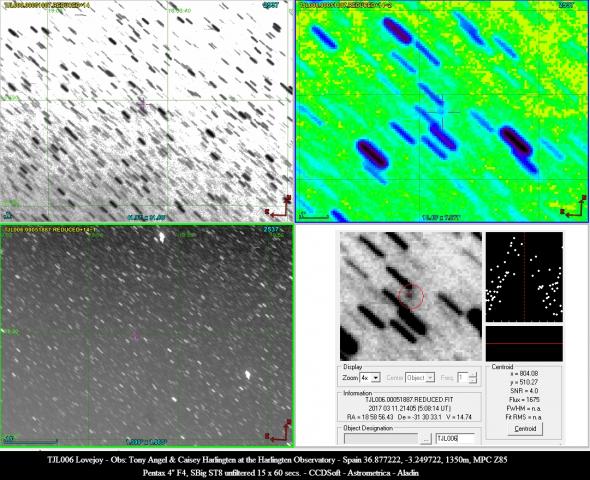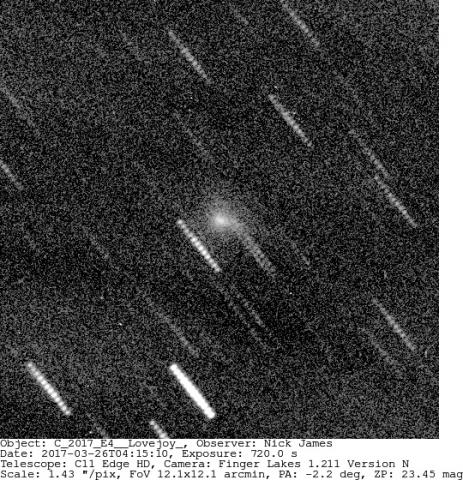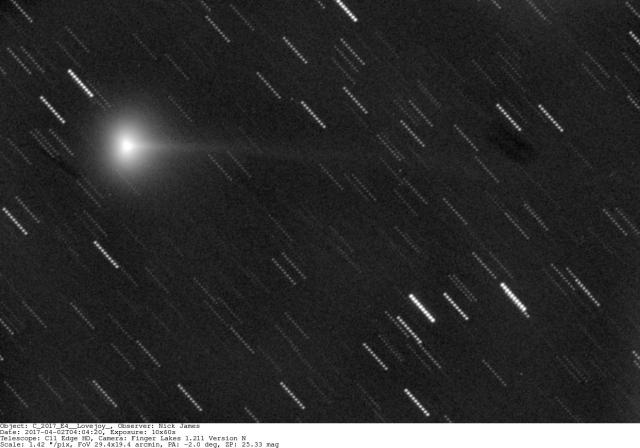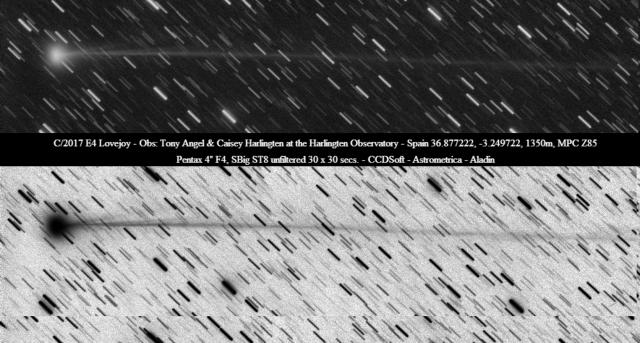- This topic has 7 replies, 2 voices, and was last updated 8 years, 8 months ago by
 Tony Angel.
Tony Angel.
-
AuthorPosts
-
12 March 2017 at 1:46 pm #573709
 Tony AngelParticipant
Tony AngelParticipant Congratulations are due again for his latest discovery.
Congratulations are due again for his latest discovery. Attachments:
12 March 2017 at 5:25 pm #578016 Nick JamesParticipant
Nick JamesParticipantWell done for getting on to Terry’s latest so quickly. It looks like it is heading for perihelion sometime around April 23rd.
Orbital elements: TJL006
Perihelion 2017 Apr 23.983223 +/- 0.434 TT = 23:35:50 (JD 2457867.483223)
Epoch 2017 Mar 12.0 TT = JDT 2457824.5 Earth MOID: 0.0106 Find_Orb
M 359.08845 +/- 0.6
n 0.02120705 +/- 0.0207 Peri. 88.82430 +/- 1.1
a 12.9265452 +/- 8.4 Node 222.71050 +/- 0.34
e 0.9622537 +/- 0.0245 Incl. 87.87017 +/- 0.10
P 46.48 H 14.7 G 0.15 U 10.1
q 0.48792827 +/- 0.00425 Q 25.3651622 +/- 71.1
From 88 observations 2017 Mar. 9-12; mean residual 0″.7012 March 2017 at 10:08 pm #578018 Tony AngelParticipant
Tony AngelParticipantThank you Nick. After hearing about Terry’s discovery I checked out “The possible Comet Confirmation Page” http://www.minorplanetcenter.net/iau/NEO/pccp_tabular.html and listed the emphemerides to get basic time and location info. I dual imaged with both the C14 and the 4″ F4 Pentax, starting when the comet was 4 degrees above the horizon. As it turned out the RA&Dec position in the emphem. were about 10 arc mins out, so it was off plate for the C14, but on for the Pentax. It was a devil of a job to find it on the low resolution image even after stacking with Astrometrica using the “/min & P.A. motion info from the site.
Note for some: All though not obvious you can backdate the emphem by putting a negative number in the :
Start ephemerides at now + hours
12 March 2017 at 10:40 pm #578019 Nick JamesParticipant
Nick JamesParticipantWith the latest astrometry the ephemeris positions should be reasonably good now. This comet is coming north rapidly but the elongation is also decreasing. According to the current astrometry it crosses the equator northbound on March 28 moving through Equuleus in the morning sky.
14 March 2017 at 12:05 am #578021 Nick JamesParticipant
Nick JamesParticipantMPEC 2017-E86 confirms this object as C/2017 E4 (Lovejoy).
26 March 2017 at 11:02 am #578063 Nick JamesParticipant
Nick JamesParticipantTerry Lovejoy’s latest comet, C/2017 E4, is now just visible from UK latitudes (52N). At the end of a long clear night of comet observing I imaged it at 0415 UT when the comet was 11 deg above the horizon and the Sun was 14 deg down. It’s not a very good image compared with observers further south and it only shows the brightest central part of the coma but it is there! Visual observers are putting it around 9th mag but the observing circumstances remain challenging for the UK.
 2 April 2017 at 10:06 pm #578086
2 April 2017 at 10:06 pm #578086 Nick JamesParticipant
Nick JamesParticipantThis comet is running much brighter than expected and it is now reasonably placed for the UK as a morning object low in the east at the start of astronomical twilight. John Toone found it by accident this morning while observing AG Peg and described it as looking a bit like a globular cluster in large binoculars.
 3 April 2017 at 5:25 pm #578089
3 April 2017 at 5:25 pm #578089 Tony AngelParticipant
Tony AngelParticipant It is well worth setting your alarm clocks to observe this comet 🙂 This image was taken this morning well before breakfast.
It is well worth setting your alarm clocks to observe this comet 🙂 This image was taken this morning well before breakfast. -
AuthorPosts
- You must be logged in to reply to this topic.
